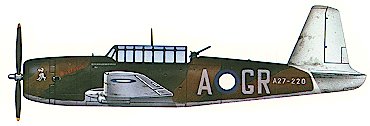CRASH OF A VULTEE VENGEANCE
AT DUM IN MIRRIE ISLAND
PORT PATTERSON, NT
ON 23 MAY 1943
![]()

Vultee Vengeance
At 1500 hours on 23 May 1943, Vultee Vengeance A27-208 of 12 Squadron RAAF, made a force landing on Dum in Mirrie Island, Port Patterson, after an electrical fire on board. The crew was Sergeant John Sheehan and Sergeant Williams. The aircraft was not recovered.
It was one of 15 Vultee Vengeances that took off from Batchelor to participate in a Fighter Interception Test. They headed over Melville Island and then Darwin where they did a dummy "bombing run" of the town. They were intercepted by Spitfires who followed them as far as Coomallie Creek.
While transiting to Melville Island, A27-208 had left the formation when pilot John Sheehan had to throw his Vengeance into a steep right hand turn to head for the coast when he discovered an electrical fire on board. His radio was not functioning, so he was unable to advise his flight leader of his predicament.
Sheehan had been flying in shoes and socks rather than the issue flying boots and molten electrical insulation was dripping onto his ankles. The fire in the fuse box was adjacent to a 17 gallon fuel trap tank. Sgt. Sheehan decided to take a risk and continue flying towards the coast.
Finally through the heat haze Sgt. Sheehan saw some tree tops on a low, flat island. He then spotted a long section of level sand at the front of the island. He made a wheels up forced landing on the sand. John Sheehan flew out of the aircraft, well before Williams, whipped off his shoes and socks, and headed for the tidal pools to cool off his burnt ankles.
They grabbed all that they could carry from the aircraft and headed across the tidal flat to the island. Unfortunately, the tide started to come in at a great speed. Darwin tides typically rise and fall 20 to 30 feet twice a day. They quickly dropped the machine gun and ammunition to lighten the load. Other goodies were also dropped in the race to shore.
They built a mosquito net tent from their parachutes in readiness for a night on the island. The lit a fire the next morning to attract the attention of a Vengeance on its daily anti-submarine patrol. Later on that morning, they increased the size of the fire, and by using a signal mirror and Verey flare they were eventually able to attract the attention of another Vengeance that was searching for them. They were subsequently rescued by a Seagull flying boat a few hours later.

Photo:- Jim Miles 8 June 2018

Photo:- Jim Miles 8 June 2018

Photo:- Jim Miles 8 June 2018

Photo:- Jim Miles 8 June 2018

Photo:- Jim Miles 8 June 2018

Photo:- Jim Miles 8 June 2018

Photo:- Jim Miles 8 June 2018
REFERENCE BOOKS
Manuscript History of 12 Squadron RAAF
ACKNOWLEDGEMENTS
I'd like to thank Jim Miles for his assistance with this web page.
Can anyone help me with more information?
"Australia @ War" WWII Research Products
|
© Peter Dunn OAM 2020 |
Please
e-mail me |
This page first produced 25 July 1999
This page last updated 21 February 2020